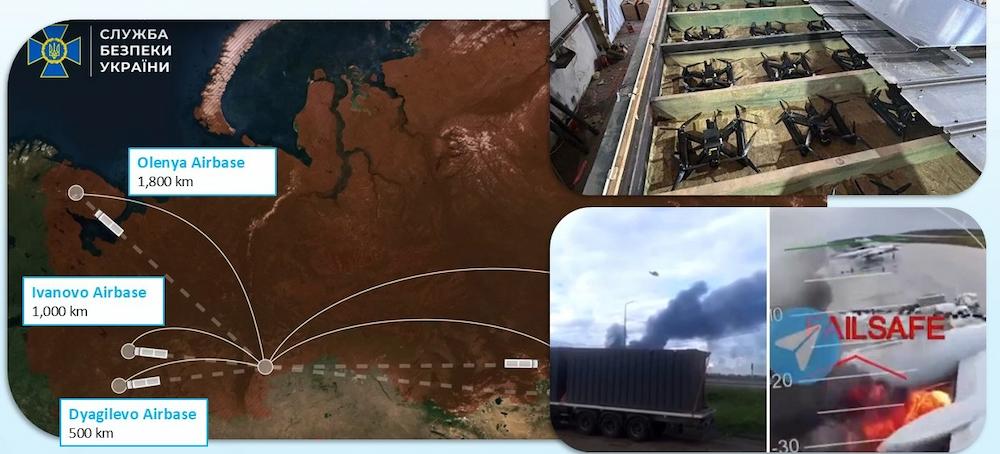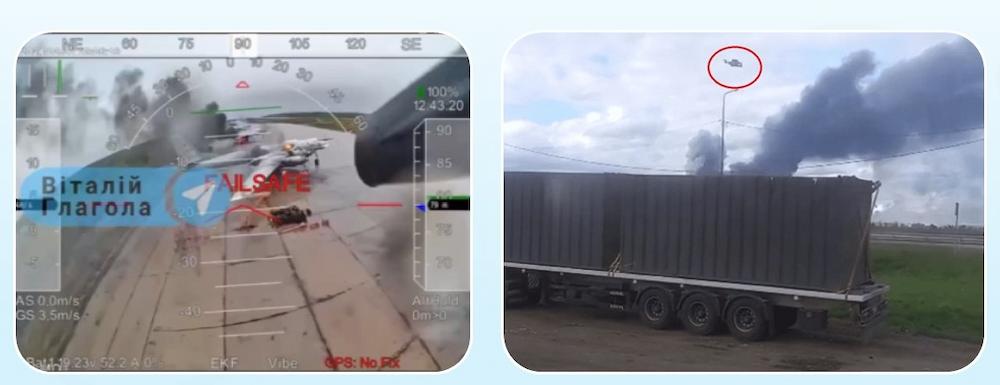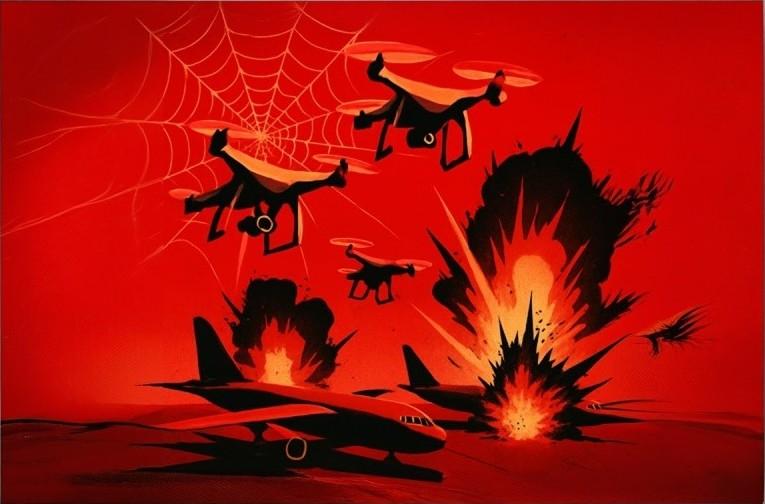In the early hours of June 1, 2025, the rules of modern warfare shifted. Ukraine’s Operation Spider’s Web—a meticulously coordinated drone assault—struck deep inside Russian territory, targeting airbases across five time zones. More than 100 drones soared from the darkness, destroying and damaging tens of military aircraft, which included about a third of Russia’s long-range strategic bomber fleet. The world watched as a new chapter in drone warfare unfolded, one that left military analysts and defense experts scrambling to understand how such a feat was possible—and how anyone could hope to stop it.
The Anatomy of Operation Spider’s Web
Operation Spider’s Web was not just another drone attack. It was a masterclass in leveraging accessible technology, strategic planning and the element of surprise. As part of the operation, Ukrainian forces moved trailers containing weaponized drones to roadside positions near Russian airbases, relying on civilian truck drivers who were unaware of the cargo’s true nature. At the appointed hour, secret compartments opened, releasing drones that lifted off into the sky, with each drone on a specific trajectory toward its target.
What set this operation apart was not just the scale, but the sophistication of its execution. The drones, identified as the “Osa” model by Ukrainian company First Contact, featured a durable closed-frame design, a payload capacity of up to 3.3 kg and a flight time of around 15 minutes. These were not state-of-the-art military drones, but commercial-grade platforms used for a strategic mission.
Cracking the Communication Code

One of the enduring mysteries was how Ukrainian pilots, operating from within their own territory, managed to control drones so far behind enemy lines. The answer lay in a clever use of communication technology. According to Yaniv Benbenisti, President and Chief Product Officer at D-Fend Solutions, the trailers acted as mobile relay stations, providing reliable communication to the drones with point-to-point RF (as used by FPV drones on the battlefield) and providing long-range communication back to Ukraine via cellular networks. This allowed operators to maintain radio contact with the drones while avoiding Russian GPS spoofing efforts near the bases. (Watch Benbenisti’s webinar on Operation Spider’s Web here).
The operation’s technical backbone was a blend of manual and autonomous control. Drones launched under manual guidance, switched to autopilot for the bulk of their journey using pre-programmed waypoints and then returned to manual control for the final strike. Even if GPS signals were jammed, the drones could continue on their path, thanks to the skilled Ukrainian pilots and the robust autopilot systems like ArduPilot, an open-source software popular among hobbyists and professionals alike.
The Art of Concealment and Destruction
Ukraine’s approach was as much about hiding its methods as it was about striking its targets. After the drones launched, the trailers self-destructed to erase evidence of the technology and tactics used. This not only protected operational secrets but also complicated Russian efforts to analyze and counter future attacks.
The use of commercial technology was deliberate. As Benbenisti noted, the operation relied on straightforward, off-the-shelf components rather than classified or expensive military hardware. This made the attack both cost-effective and difficult to anticipate, as traditional countermeasures like GPS jamming or cell signal disruption proved largely ineffective against such adaptable systems.
Why Traditional Defenses Failed

Operation Spider’s Web exposed the limitations of conventional air defense systems. Radars, kinetic interceptors, and GNSS jammers/spoofers are designed to detect and destroy large, fast-moving objects at high altitudes. Small, low-flying drones, especially those operating in swarms or waves, are much harder to spot and intercept. Their slow speed, low altitude and small radar signature allow them to slip past defenses that would easily detect a fighter jet or cruise missile.
Moreover, the attack demonstrated that simply jamming GPS or cellular signals is no longer enough. The drones’ ability to switch between manual, radio and autonomous control modes meant they could adapt to changing conditions and continue their mission even in highly contested environments.
The Weakest Link: Communication
With traditional defenses falling short, attention has turned to the communication link between drone and operator. Detecting and taking over this link has become a key focus for counter-drone firms like D-Fend Solutions. Severing the connection can neutralize a drone before it reaches its target.
The Implications: A New Era of Threats
Operation Spider’s Web highlights the urgent need for militaries and security agencies around the world to reassess their preparedness for emerging drone threats. The technology used is not confined to Ukraine or Russia; it is available to anyone with a modest budget and technical know-how. For a few thousand dollars, individuals or groups can assemble a fleet of drones capable of carrying out devastating attacks on strategic targets.
This democratization of drone warfare means that critical infrastructure, airports and civilian mass gatherings are now potential targets. The barrier to entry is low and the potential for disruption is high. Small commercial and do-it-yourself (DIY) drones have evolved from tactical nuisances to strategic threats, capable of bypassing even the most advanced air defense systems. Some of these drones can be bought today with a nest box that allows easy transportation, charging, and even remote control via the internet.
What’s Next? Defending Against the Web

So, how do you stop a Spider’s Web of drones? The answer lies in a multi-layered approach that combines detection, identification and rapid mitigation. (See prior AG coverage here).
Cyber-based counter-drone solutions, such as radio frequency (RF) takeover systems, offer a promising avenue by allowing defenders to seize control of hostile drones and neutralize them safely. RF-cyber takeover uses RF technology to detect, identify, monitor, and take command of unauthorized drones. Unlike traditional jamming, which disrupts all communications in the vicinity, RF-cyber solutions offer targeted intervention. This enables security teams to safely guide or land drones at specific locations, minimizing the risk of unintended interference or collateral damage.
A layered defense strategy often relies on RF-cyber as a core component. By combining RF-cyber with radar, optical sensors and kinetic or directed-energy solutions, security teams can build a comprehensive system that addresses the weaknesses of individual technologies and ensures more robust protection.
D-Fend Solutions engineered its EnforceAir system for smooth interoperability with a range of other counter-UAS technologies. For example, radar systems deliver real-time, active detection of aerial threats, while EnforceAir can be integrated to provide additional detection, as well as targeted identification and mitigation. This collaborative approach enables security teams to leverage the strengths of each technology, creating a more comprehensive and effective defense against unauthorized drones.
As drones become more sophisticated, expect to witness further innovation in both offense and defense. Furthermore, as drone technology continues to evolve, so too must the strategies and tools used to counter it. The battle for the skies is no longer the exclusive domain of nation-states and billion-dollar weapons programs. It is a contest of ingenuity, adaptability, and relentless experimentation—a contest that has only just begun.
Watch D-Fend Solutions’ Gordon Kesting, VP U.S. Sales and Business Development on the Dawn of Autonomy 2025 here.

